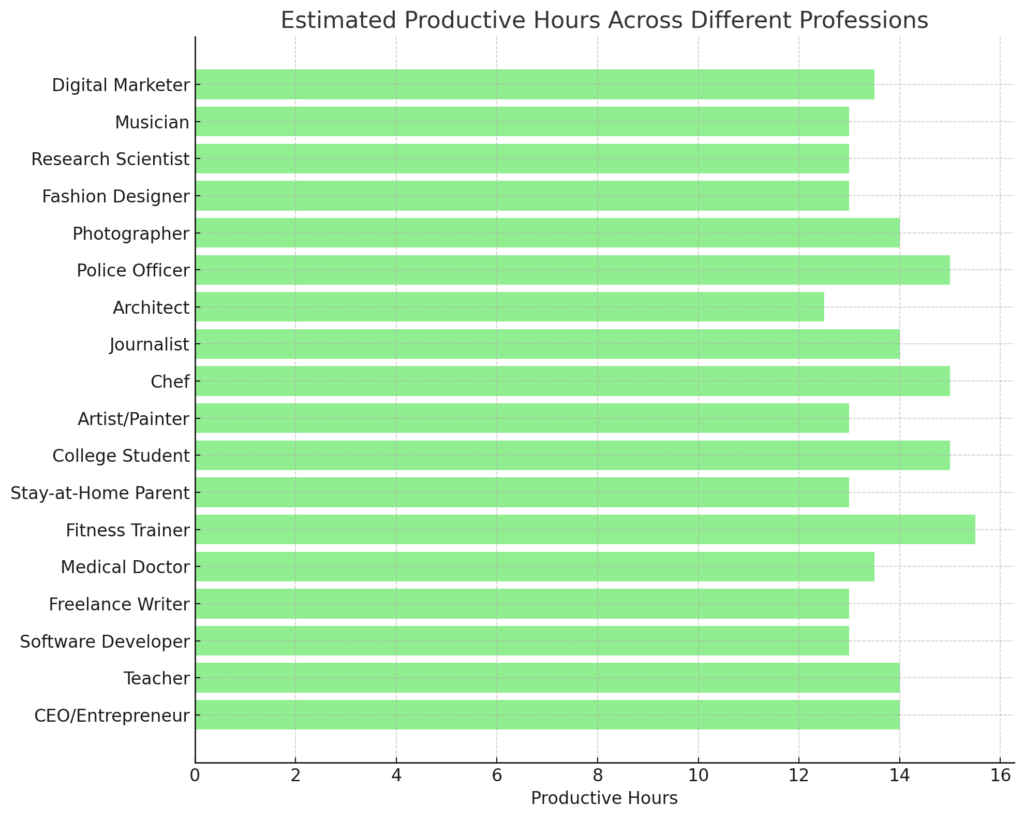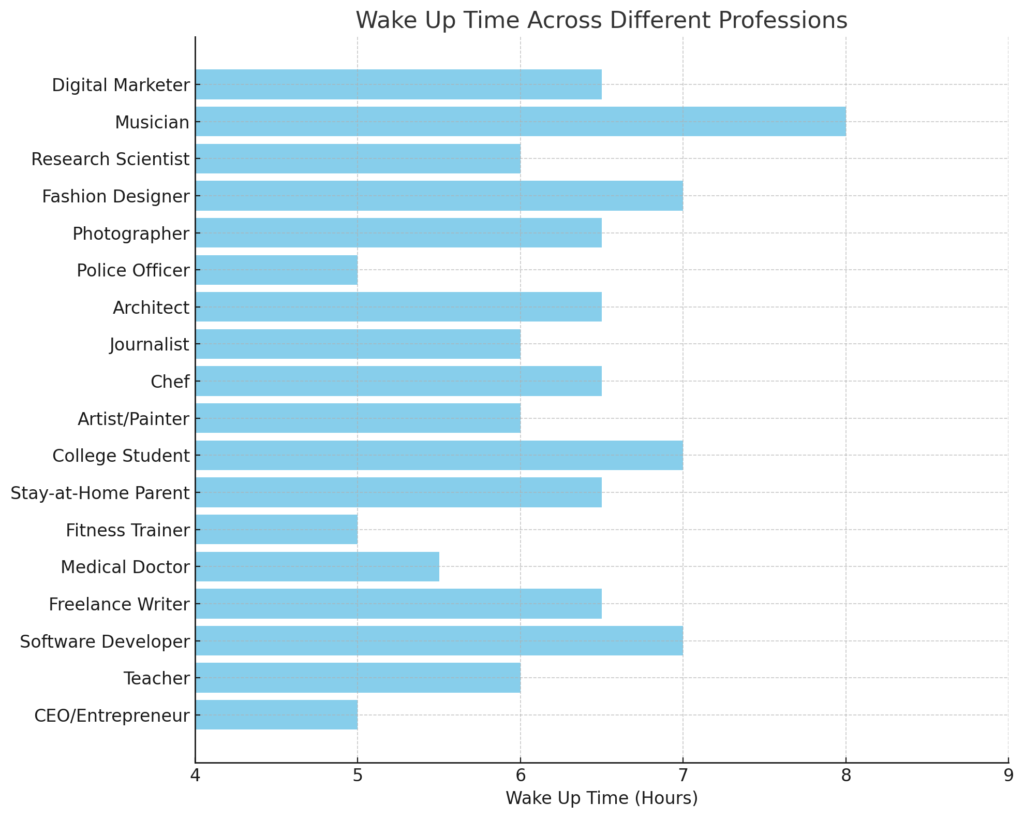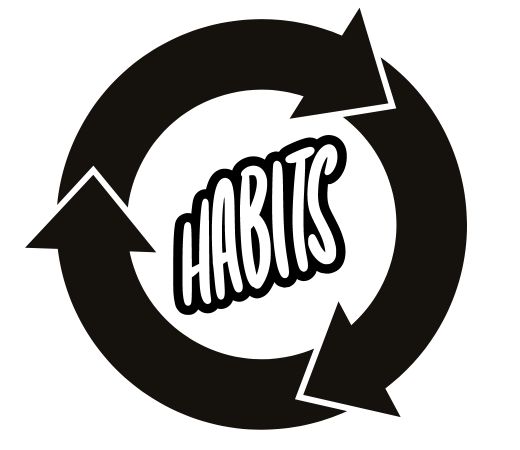Page Contents
Are you feeling overwhelmed by your day?
You’re not alone—88% of people like Bryan Johnson and Andrew Huberman say routines are vital for productivity as well as health, but only 20% feel they have an effective structure (Forbes, 2023).
Imagine reducing stress and boosting productivity by making small changes to your daily schedule.
Duke University research shows that 40% of daily actions are habits – A well-planned routine can automate success.
Top performers like Tim Cook, who wakes up at 4:30 AM daily, attribute much of their success to structured routines.
By learning from their examples, you can build a routine that suits your goals.
In this article, Routine Bias has listed some of the best daily routine examples based on real-world professions.”
Let’s get started!
Daily Routine Examples Analysis
| Profession and Wake Up Time | Main Morning & Afternoon Activity | Wind Down Activity and Bedtime |
| CEO/Entrepreneur (Wake Up: 5:00 AM) | Exercise and Meditation | Creative Work | Family Time | Bedtime: 9:00 PM |
| Teacher (Wake Up: 6:00 AM) | Prepare Lessons | Teach or Grade Work | Relax with Family | Bedtime: 10:00 PM |
| Software Developer (Wake Up: 7:00 AM) | Check Emails and Plan | Coding | Watch Tutorials or Relax | Bedtime: 10:00 PM |
| Freelance Writer (Wake Up: 6:30 AM) | Journaling | Client Calls | Relax and Read | Bedtime: 10:00 PM |
| Medical Doctor (Wake Up: 5:30 AM) | Exercise | Patient Rounds | Family Time | Bedtime: 9:00 PM |
| Fitness Trainer (Wake Up: 5:00 AM) | Train Clients | Train More Clients | Review Client Progress | Bedtime: 9:30 PM |
| Stay-at-Home Parent (Wake Up: 6:30 AM) | Prepare Breakfast for Kids | Help with Kids Homework | Personal Time | Bedtime: 10:00 PM |
| College Student (Wake Up: 7:00 AM) | Study | Extracurricular | Socialize | Bedtime: 11:00 PM |
| Artist/Painter (Wake Up: 6:00 AM) | Sketch or Creative Work | Painting or Sketching | Reflect on Work | Bedtime: 9:00 PM |
| Chef (Wake Up: 6:30 AM) | Prepare for Service | Dinner Prep | Review for Next Day | Bedtime: 11:00 PM |
| Journalist (Wake Up: 6:00 AM) | Check News | Writing Articles | Read or Personal Writing | Bedtime: 10:00 PM |
| Architect (Wake Up: 6:30 AM) | Design Work | Client Meetings | Creative Exploration | Bedtime: 9:00 PM |
| Police Officer (Wake Up: 5:00 AM) | Patrol and Briefing | Report Writing | Spend Time with Family | Bedtime: 9:00 PM |
| Photographer (Wake Up: 6:30 AM) | Photoshoot Preparation | Editing Photos | Review Photos | Bedtime: 10:00 PM |
| Fashion Designer (Wake Up: 7:00 AM) | Design Inspiration | Client Consultations | Design and Relax | Bedtime: 10:00 PM |
| Research Scientist (Wake Up: 6:00 AM) | Experiment and Research | Data Analysis | Reflect on Research | Bedtime: 9:00 PM |
| Musician (Wake Up: 8:00 AM) | Practice Music | Collaborate with Musicians | Relax and Review Music | Bedtime: 11:00 PM |
| Digital Marketer (Wake Up: 6:30 AM) | Check Social Media and Trends | Campaign Performance Review | Review Strategies | Bedtime: 10:00 PM |


Example of CEO/Entrepreneur’s Daily Routine

- 5:00 AM: Wake up, meditate, and plan the day.
- 5:30 AM: Exercise (yoga, running, or weightlifting).
- 6:30 AM: Healthy breakfast (smoothie, eggs, or oatmeal).
- 7:00 AM: Check emails, review daily goals, and team updates.
- 8:00 AM: Strategic meetings or decision-making sessions.
- 10:00 AM: Focused work on high-priority tasks.
- 12:00 PM: Lunch with networking or alone time.
- 1:00 PM: Creative tasks or brainstorming new business ideas.
- 3:00 PM: Customer or investor calls.
- 5:00 PM: Review the day’s progress and adjust tasks for the next day.
- 6:00 PM: Wind down with family, reading, or personal hobbies.
- 9:00 PM: Sleep preparation, reading, or reflection on the day.
Routine Bias has been researched over 41 CEOs’ waking-up schedules with quick morning routines.
Example of Teacher’s Daily Routine

- 6:00 AM: Wake up and have breakfast.
- 7:00 AM: Arrive at school, prepare lessons and classroom.
- 8:00 AM: Teach classes, monitor students, and engage in interactive learning.
- 12:00 PM: Lunch and light conversation with colleagues.
- 1:00 PM: Continue with lessons or grade student work.
- 3:00 PM: After-school support for students or administrative tasks.
- 5:00 PM: Review the day’s lessons and plan for the next day.
- 6:00 PM: Relax, spend time with family, and pursue hobbies.
- 10:00 PM: Go to bed.
Example of Software Developer’s Daily Routine

- 7:00 AM: Wake up and stretch.
- 7:30 AM: Check emails and work messages.
- 8:00 AM: Breakfast, light reading on the latest tech trends.
- 9:00 AM: Start coding tasks for the day.
- 11:00 AM: Team meeting or sprint planning.
- 12:00 PM: Lunch break, often a walk to clear the mind.
- 1:00 PM: Focused coding time (debugging, testing, or developing features).
- 3:00 PM: Collaborate with team members or work on problem-solving.
- 5:00 PM: Wrap up coding and prepare for the next day’s work.
- 6:00 PM: Relax, watch tutorials, or work on side projects.
- 10:00 PM: Bedtime.
Example of Freelance Writer’s Daily Routine

- 6:30 AM: Wake up, meditate, and journal.
- 7:00 AM: Breakfast while reading news or articles for inspiration.
- 8:00 AM: Outline articles or blog posts.
- 9:00 AM: Writing session 1 (focus on creativity and drafting).
- 11:00 AM: Break and light exercise.
- 12:00 PM: Lunch break.
- 1:00 PM: Writing session 2 (editing, reviewing, or completing tasks).
- 3:00 PM: Client calls or project updates.
- 4:00 PM: Continue writing or brainstorming new topics.
- 6:00 PM: Wind down, review work, and set goals for the next day.
- 8:00 PM: Relax with a book or TV show before bed at 10:00 PM.
Example of a Doctor’s Daily Routine

- 5:30 AM: Wake up and exercise.
- 6:30 AM: Breakfast and review the day’s schedule.
- 7:30 AM: Arrive at the hospital/clinic and attend morning briefings.
- 8:00 AM: Patient consultations, medical examinations, or surgeries.
- 12:00 PM: Lunch break, often catching up on medical journals or reports.
- 1:00 PM: Continue with rounds, patient reviews, or procedures.
- 3:00 PM: Administrative work, writing patient notes, or following up on tests.
- 5:00 PM: Leave the hospital/clinic and review cases for the next day.
- 6:00 PM: Family time, personal hobbies, or relaxation.
- 9:00 PM: Bedtime.
Example of a Fitness Trainer’s Daily Routine

- 5:00 AM: Wake up and have a light snack.
- 6:00 AM: Train clients (either one-on-one or group classes).
- 9:00 AM: Personal workout.
- 10:00 AM: Breakfast, respond to client inquiries, and check progress reports.
- 11:00 AM: Train more clients or plan new fitness routines.
- 1:00 PM: Lunch and rest.
- 2:00 PM: Work on content creation (blogs, social media) or fitness plans.
- 4:00 PM: Train afternoon clients.
- 6:00 PM: Wrap up client check-ins and review the day.
- 7:00 PM: Relax and spend time with family/friends.
- 9:30 PM: Bedtime.
Example of a Stay-at-Home Parent’s Daily Routine

- 6:30 AM: Wake up, cook breakfast for kids, and do household chores.
- 7:30 AM: Drop kids off at school.
- 8:00 AM: Morning exercise or meditation.
- 9:00 AM: Tidy the house or run errands.
- 11:00 AM: Prep lunch and light tasks.
- 12:00 PM: Eat lunch or relax with a book.
- 1:00 PM: Pick up kids or help with homework.
- 3:00 PM: Afternoon activities with kids or family time.
- 5:00 PM: Prepare dinner, clean up, and wrap up the day.
- 8:00 PM: Personal downtime or family activities before bedtime.
Example of a College Student’s Daily Routine

- 7:00 AM: Wake up and exercise.
- 7:30 AM: Breakfast and review study plan.
- 8:00 AM: Attend classes or study sessions.
- 12:00 PM: Lunch with friends or at the library.
- 1:00 PM: Group projects, lab work, or assignments.
- 3:00 PM: Study or review course materials.
- 5:00 PM: Part-time work or internships.
- 7:00 PM: Socializing, extracurricular activities, or relaxation.
- 10:00 PM: Review notes, set goals, and sleep by 11:00 PM.
Example of an Artist/Painter’s Daily Routine

- 6:00 AM: Wake up and meditate or practice Nidra Yoga.
- 7:00 AM: Sketch or write down creative ideas while having breakfast.
- 8:00 AM: Begin painting or working on a current project.
- 10:00 AM: Take a break, walk outside, or visit an art gallery for inspiration.
- 11:00 AM: Continue working on creative pieces, refining and adding details.
- 1:00 PM: Lunch and light activity, such as reading or watching documentaries.
- 2:00 PM: Work on marketing or updating social media with recent artwork.
- 4:00 PM: Attend an art class or collaborate with other artists.
- 6:00 PM: Wind down with hobbies or personal projects.
- 9:00 PM: Reflect on the day’s creative progress, relax, and head to bed.
Example of Chef’s Daily Routine

- 6:30 AM: Wake up, enjoy a healthy breakfast, and check the menu for the day.
- 8:00 AM: Arrive at the restaurant or kitchen, review the ingredients, and prepare for the day.
- 10:00 AM: Begin cooking and prepping dishes for lunch service.
- 12:00 PM: Lunch service rush (oversee the kitchen, ensure quality, and lead the team).
- 3:00 PM: Post-lunch cleanup and prep for dinner service.
- 4:00 PM: Rest or experiment with new recipes.
- 5:00 PM: Dinner service preparation and leadership.
- 9:00 PM: Clean up, review the day’s performance, and plan for the next day.
- 11:00 PM: Wind down and go to bed.
Example of a Journalist’s Daily Routine

- 6:00 AM: Wake up, check the news, and scan through social media or key publications.
- 7:00 AM: Morning exercise, breakfast, and planning the day’s stories.
- 8:00 AM: Write, research, or prepare for interviews.
- 10:00 AM: Interview sources, attend press conferences, or work on-site.
- 12:00 PM: Lunch break and catch up on social media updates.
- 1:00 PM: Write articles, edit work, or report on live events.
- 4:00 PM: Pitch new story ideas and collaborate with editors.
- 6:00 PM: Finalize articles for the day and submit work for publication.
- 8:00 PM: Wind down by reading or engaging in personal writing.
- 10:00 PM: Bedtime.
Example of Architect’s Daily Routine

- 6:30 AM: Wake up, morning workout, or walk.
- 7:30 AM: Breakfast while reviewing design inspirations or architecture trends.
- 8:30 AM: Start working on current projects (blueprints, sketches, CAD design).
- 11:00 AM: Team meetings or client consultations.
- 12:00 PM: Lunch break.
- 1:00 PM: Focused design work, client revisions, or project development.
- 3:00 PM: Site visits or material selections with clients/contractors.
- 5:00 PM: Review project timelines and prepare for the next day.
- 6:00 PM: Personal time, hobbies, or creative exploration.
- 9:00 PM: Relax and get ready for bed.
Example of a Police Officer’s Daily Routine

- 5:00 AM: Wake up, stretch, and eat breakfast.
- 6:00 AM: Arrive at the station, check assignments, and review briefing.
- 7:00 AM: Patrol assigned area, respond to emergency calls, or investigate reports.
- 12:00 PM: Lunch break at the station or in the field.
- 1:00 PM: Continue patrolling, documenting incidents, or filing reports.
- 4:00 PM: Attend training sessions or review crime prevention strategies.
- 6:00 PM: Wrap up the day, write reports, and discuss cases with colleagues.
- 7:00 PM: Go home, relax, and spend time with family.
- 9:00 PM: Sleep early for the next shift.
Example of Photographer’s Daily Routine

- 6:30 AM: Wake up, light breakfast, and check the day’s shoot plans.
- 8:00 AM: Arrive at the location or studio, set up equipment and lighting.
- 9:00 AM: Begin the photo session (portrait, landscape, event).
- 12:00 PM: Lunch break, relax, and review shots.
- 1:00 PM: Continue shooting, experimenting with angles and light.
- 4:00 PM: Edit photos or curate the portfolio.
- 6:00 PM: Meet with clients to discuss their vision or review work.
- 7:00 PM: Personal time, explore creative ideas, or do a passion project.
- 10:00 PM: Bedtime.
Example of a Fashion Designer’s Daily Routine

- 7:00 AM: Wake up and get inspired by fashion magazines or runway shows.
- 8:00 AM: Sketch new design ideas or review current collections.
- 10:00 AM: Visit fabric stores or consult with tailors/seamstresses.
- 12:00 PM: Lunch break while brainstorming fashion trends.
- 1:00 PM: Work on prototypes, fabrics, or fittings.
- 3:00 PM: Client meetings, discussing custom designs or upcoming shows.
- 5:00 PM: Prepare for an upcoming fashion show or photoshoot.
- 7:00 PM: Reflect on the day, organize designs, and unwind.
- 10:00 PM: Sleep.
Example of a Research Scientist’s Daily Routine

- 6:00 AM: Wake up and exercise.
- 7:00 AM: Breakfast and read scientific articles or the latest research updates.
- 8:00 AM: Arrive at the lab, conduct experiments, and record observations.
- 12:00 PM: Lunch break, relax, or discuss findings with colleagues.
- 1:00 PM: Analyze data, adjust hypotheses, and refine experiments.
- 4:00 PM: Write reports, prepare presentations, or submit papers.
- 6:00 PM: Leave the lab, spend time with family, or enjoy a personal hobby.
- 9:00 PM: Reflect on the research progress and plan for the next day.
- 10:00 PM: Sleep.
Example of Musician’s Daily Routine

- 8:00 AM: Wake up, light stretches, and practice vocals or instruments.
- 9:00 AM: Breakfast and review music compositions or lyrics.
- 10:00 AM: Studio time for recording or practising.
- 12:00 PM: Lunch and short break.
- 1:00 PM: Continue composing, rehearsing, or collaborating with other musicians.
- 4:00 PM: Attend meetings with producers, band members, or sound engineers.
- 6:00 PM: Evening performance, jam session, or gig.
- 9:00 PM: Relax, wind down, and review the day’s music.
- 11:00 PM: Bedtime.
Example of Digital Marketer’s Daily Routine

- 6:30 AM: Wake up and review the latest marketing news.
- 7:30 AM: Breakfast while checking emails and social media trends.
- 8:30 AM: Start work, manage ad campaigns, and analyze metrics.
- 10:00 AM: Team meeting to review strategy and goals.
- 12:00 PM: Lunch break and monitor campaign performance.
- 1:00 PM: Create content or optimize SEO and social media posts.
- 3:00 PM: Analyze audience feedback and engagement data.
- 5:00 PM: Review marketing plans and refine strategies for the next day.
- 6:00 PM: Relax, learn new digital marketing techniques, or unwind.
- 10:00 PM: Sleep.
Now that you are familiar with routine examples, let’s understand the benefits of adopting a daily routine in life.
Benefits of Having a Routine in Life
Increased Productivity: As experienced by people like Bryan Johnson, Andrew Huberman, and other routine followers – A routine structures your day. In addition, it helps you prioritize important tasks and manage life.
Reduced Stress: A routine helps in reducing random decision fatigue, uncertainty, and anxiety. It offers a sense of control over your time. With time, you feel improved mental health and relaxed.
Formation of Good Habits: As James Clear said, habits help improve quality of life. Following a routine will improve positive habits such as exercising, eating healthy, or reading.
Increased Efficiency: With routines, you’re not wasting time figuring out what to do next. A routine is to streamline your day, ensuring that important tasks are handled consistently.
Goal Achievement: By adapting to daily routine, you can break down big goals into manageable daily actions, leading to steady progress in life.
Tips for Creating a Daily Routine
Prioritize: You should focus on what matters most (e.g., office/personal work, family, health) and design your daily routine accordingly.
Peak Times: You should start with important tasks as you are more energetic in the morning (Example: If you’re a morning person, handle creative tasks early).
Time Blocks: Break your day tasks into small parts, leaving buffer time (Example: 9-11 AM for work, 11-11:30 AM break).
Balance: Mix your work, exercise, and fun to avoid burnout (Example: 30 minutes of reading or a walk after lunch).
Start Small: Introduce 1-2 habits at a time, like adding a 10-minute morning stretch.
Healthy Habits: Include daily exercise, sleep, and mindfulness (Example: Meditate for 5 minutes before bed).
Use Tools or Apps: Start using routine apps or calendars to stay organized (Example: Google Calendar for daily scheduling).
Maintain Consistency: Stick to your routine, but have some flexibility (Example: Skip a workout without guilt if needed).
Related Routines 👀
Routine Inspiration for Different Life Stages
- Students: As a student, you should focus on study times, class schedules, and extracurricular activities while making room for relaxation and socializing.
- Young Professionals: Build your daily routine that helps in managing work-life balance and develop healthy habits like exercise, learning, and skill-building.
- Parents: A parent routine should involve both personal time and family time, with an emphasis on flexibility to adapt to children’s changing needs.
- Retired Individuals: As a retired person, focus your daily routine on activities that bring joy and fulfilment. You can pursue hobbies, volunteering, and staying physically active.

